Imagine you’re at a horse race, looking at a horse sprint at breakneck speed around the track. You can see its powerful muscles working hard under its coat. Have you ever seen a horse’s ears?
They’re always moving, aren’t they? Like tiny satellite dishes, catching every sound.
You’ve probably asked yourself why horses act like this. This article will explain some cool facts about horses and their behaviors.
Being an animal in the wild is no easy task. You either chase your meal or become someone else’s.
It’s a tough world out there! Horses, like other animals, have evolved to handle these harsh realities. You may be thinking, ‘Horses? Really? Aren’t they just for riding and racing?’
Yes, we often see horses in that role, but they’ve got a whole lot more going on.
Now, picture a horse’s ear again. Why do you think it moves so much? It’s not just a funny habit – it’s a survival trick! A horse’s ears swivel around to catch sounds from all directions.
That way, they can pick up on any potential dangers, like a predator sneaking up on them.
And what about that amazing speed you see at the horse race? Horses are naturally fast runners, and they use this speed not just for racing but for escaping predators in the wild.
If you were a horse, running fast could mean the difference between life and death!
In the world of horses, there’s much more than meets the eye. These animals are not just beautiful to look at; they’re smart and tough, ready to face whatever comes their way.
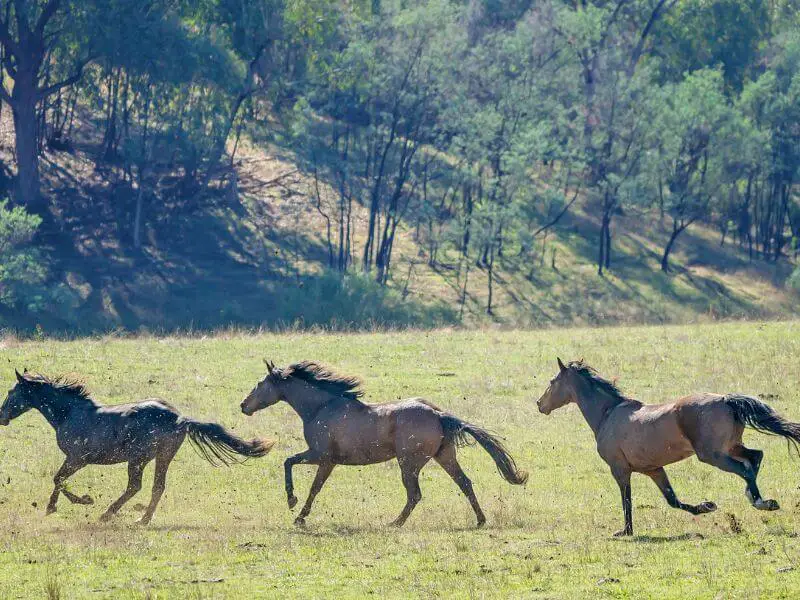
Understanding Horses as Prey Animals
Are Horses Prey Animals?
When we think about horses, we usually imagine them as strong, fast, and free creatures. But there’s more to their story. Horses, in the wilderness, fall under the ‘prey’ category.
They are the ones that predators often seek in the food chain. But these intelligent animals are not defenseless. Through the ages, horses have developed amazing adaptations to escape these predators.
What Is A Prey Animal?
But first, let’s backtrack a bit. What exactly do we mean when we say an animal is a ‘prey’ animal? A prey animal is one that’s naturally hunted and eaten by other animals.
They are almost always herbivores or plant eaters and often at the bottom of the food chain. Prey animals have to be pretty crafty to avoid becoming someone’s lunch.
They’ve developed all sorts of tricks, like keen senses, camouflage, and behaviors that help them live in big groups.
What Is A Predator Animal?
A predator is the flip side of the coin in the animal kingdom.
These are animals that hunt and eat other animals – the prey They are often carnivores which means that their main diet is meat, but they can be omnivores which means meat and plants are part of the diet.
They are often higher up on the food chain.
Predators are equipped with their own set of adaptations that make them efficient hunters.
This can include sharp teeth and claws, superior speed, strength, stealth, and even advanced hunting tactics.
Predators come in many shapes and sizes, from the large and powerful like lions, tigers, and sharks, to the small but fierce like spiders and owls.
In the case of horses, their predators in the wild would typically be large carnivores such as wolves, mountain lions, and in some parts of the world, even big cats like tigers.
Understanding the predator-prey relationship is a vital part of appreciating how balanced ecosystems function. It’s a bit like a complicated dance, with each side constantly adjusting and adapting to the other’s moves.
Adapting to Survive: Equine Characteristics as Prey Animals
Horses have a remarkable array of adaptations to thrive as prey animals. Here are a few notable ones:
- Equine Eyesight: Horses’ eyes are on the sides of their heads, a placement that gives them a wide field of view to keep an eye out for sneaky predators.
- Flight: When danger appears, horses rely on their incredible speed to escape, leaving their pursuers eating dust.
- Herd Hierarchy: Horses prefer to stick together in herds, a social structure that offers an additional layer of protection.
- Equine Instincts: Horses are very alert and sensitive to their surroundings, picking up on the smallest signs of danger. This acute sensitivity forms a significant part of horse communication.
- Powerful Hindquarters: If the situation calls for it, a horse can unleash a powerful kick thanks to its strong hindquarters.
How Horses Demonstrate Their Prey Instincts In Their Natural Behavior
Okay, so how does all this play out in real life? Horses are always on high alert.
They react swiftly to danger – usually by making a quick exit, stage left. When they’re in a herd, some of them will be on lookout duty while the rest eat or rest.
Signs Of Stress Or Anxiety In Horses Due To Their Prey Instincts
Like us humans, horses also experience stress and anxiety. Indicators of this can include rapid breathing, restlessness, or excessive sweating.
In some cases, horses may develop vices such as cribbing or weaving due to persistent stress. When horses are stressed or anxious they can also respond aggressively as a response when they feel they have no choice or they have found the behavior was effective at getting what they want.
How Horses’ Adaptations Help Them Survive
These adaptations aren’t just cool party tricks – they’re central to a horse’s survival. Keen senses and speed help them spot danger and make a quick getaway.
Living in a herd gives them an extra layer of protection. When danger appears, the herd can scatter in different directions, confusing the predator and upping the horse’s chance of escape.
How Horses’ Instincts As Prey Animals Affect Their Behavior In The Wild V.S. Domestic Settings
Even when they’re living the pampered life of a domestic horse, their prey instincts are still in play. They might startle easily or be cautious of new things or places.
They often prefer to be with other horses. But don’t worry – with proper training, you can help them feel safe and secure in their new surroundings, teaching them to trust humans and not to freak out over every little thing.
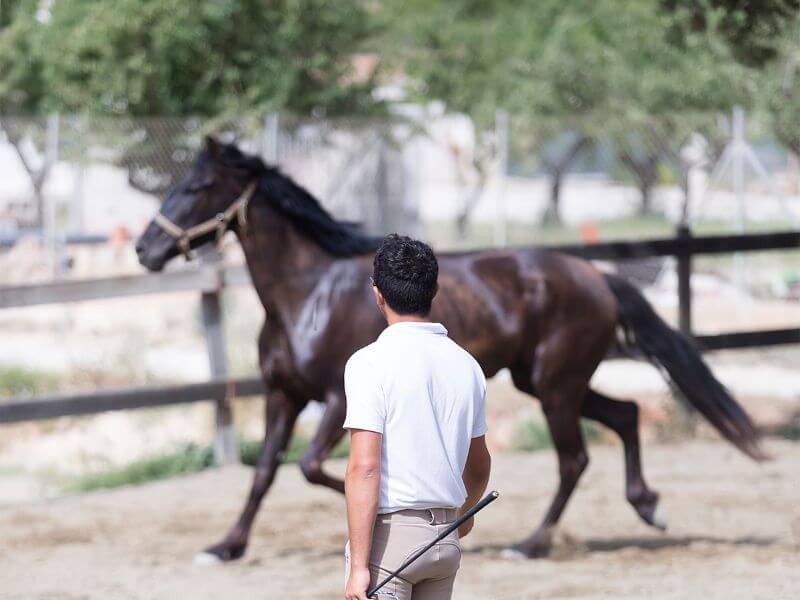
Interaction and Training: Harnessing Prey Instincts
When we think about interacting with horses, we often imagine the serene scenes from movies or books, where the protagonist tames a wild horse and rides into the sunset.
But behind this romanticized image, there’s a complex dynamic going on. A dynamic deeply rooted in the survival instincts of horses and our understanding of them.
Let’s explore how these aspects shape our interaction and training of horses.
Do Horses Perceive Humans as Predators?
Well, yes and no. When we first encounter horses, their initial instinct might categorize us as predators. This is because we often approach them the way predators do in the wild – directly and with our gaze focused on them.
But don’t worry, this doesn’t mean they’re ready to bolt every time they see us. Horses can learn over time that humans aren’t threats.
Through gentle and patient interactions, we can win their trust and ease their initial wariness.
Why it’s Important to Understand How to Interact with Horses as Prey Animals
Understanding the prey nature of horses is like learning a foreign language before visiting a new country. It helps us communicate better and navigate through potential misunderstandings.
As prey animals, horses are vigilant, anxious, and reactive. Recognizing these behaviors can guide us to approach and interact with them in ways that minimize stress, build trust, and promote positive experiences.
Also, let’s not forget that triggering a horse’s flight response can turn an otherwise calm scenario into a dangerous one quickly.
How You Can Establish Trust with Horses Despite Their Prey Instincts
Building trust with a horse is a bit like making a new friend. It involves behaving in a non-threatening way, being consistent, and rewarding good behavior. Remember the old saying “actions speak louder than words”?
That applies perfectly here. Over time, through our actions, horses can associate humans with safety and positive experiences, overcoming their initial fear.
How You Can Utilize Horses’ Prey Instincts for Training Purposes
Horses’ prey instincts aren’t just obstacles to overcome; they can also be tools for training. Their fear response, for example, can guide us in carefully introducing them to different stimuli.
Likewise, their herd instinct and social hierarchy can be harnessed during training, with the human taking the role of a ‘lead mare’ to guide behavior.
Understanding these instincts helps us create training methods that align with their natural behavior, making training less stressful and more effective.
The Initial Interactions Between Humans and Horses Like, Considering Their Predator-Prey Relationship
The first meetings between humans and horses were likely a far cry from our relationships with them today. Back then, humans were predators and horses were prey.
Over many generations, humans transitioned from hunting horses to taming and riding them, shifting from a predator-prey dynamic to a partnership.
This monumental change would have required considerable adaptations from both species.
How You Can Work with Horses’ Prey Instincts to Build a Positive Relationship with Them
Just as a good friendship requires understanding and respect, so does building a positive relationship with a horse.
This involves understanding their instincts, respecting their need for safety, and learning to communicate in a way that makes sense to them. Building trust through consistent, positive experiences forms the foundation of this relationship.
Remember, patience is key. With time and understanding, you can build a strong, positive relationship with these magnificent creatures.
So, the next time you find yourself around horses, remember that you’re interacting with a species that has survived as prey for millions of years.
But don’t let that intimidate you. With patience, understanding, and respect for their instincts, you can establish a meaningful bond with these amazing animals.
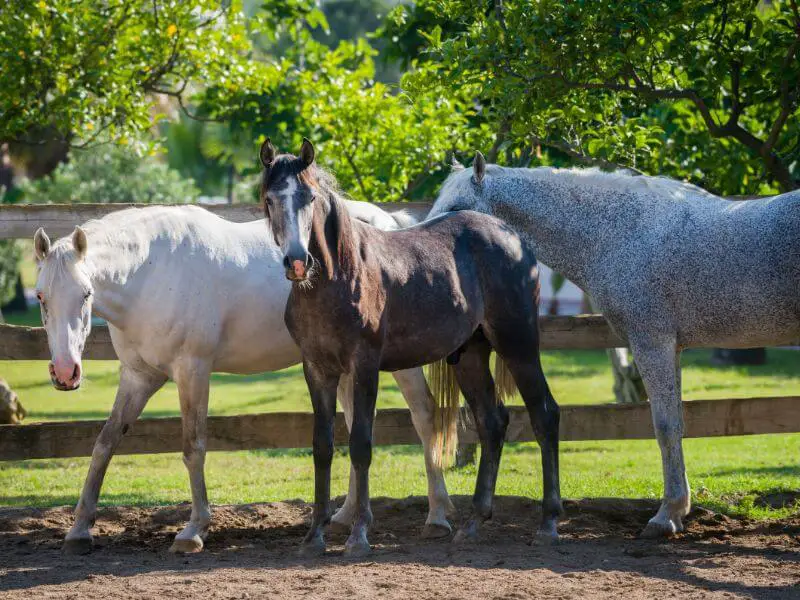
Herd Dynamics: Survival Strategies
Did you know that horses are a lot like us when it comes to their social lives? They hang out in groups, have their best buddies, and look out for each other just like we do.
This makes perfect sense when we remember that horses are prey animals.
Let’s explore how herd life plays out for horses, and how it all ties back to their survival instincts.
How Herd Life Protect Horses As Prey Animals
Horses like to hang out in groups, and there’s a good reason for this. Living in a herd is kind of like having a neighborhood watch program.
With multiple pairs of eyes on the lookout, it’s much easier to spot danger. If a predator gets too close, the herd can scatter in different directions. This makes it harder for the predator to focus on just one horse, giving everyone a better chance of getting away safely.
Besides providing protection, herds also offer horses the chance to socialize and feel secure, much like we do when hanging out with our friends and family.
The Role Of The Lead Mare In A Horse Herd And Its Relation To Prey Instincts
You might think that the biggest and strongest horse would be the one in charge. But in horse herds, it’s often a female horse, or mare, that leads the way.
This lead mare has a big responsibility. She’s the one who decides when it’s time to search for food or water and where the herd should go. It’s kind of like having a tour guide who knows all the best places to eat and drink! But being a leader isn’t all fun and games.
The lead mare is often the first to react to danger, and her actions signal to the rest of the herd how they should respond. So she plays a big role in keeping everyone safe from predators.
How The Presence Of A Stallion In A Horse Herd Contribute To Their Survival As Prey Animals
While the lead mare might be the guide, the stallion is often the protector of the herd. He’s like the security guard who stays alert for any danger.
Stallions usually hang out at the back of the group, ready to spring into action if a predator shows up. If a threat is detected, they’ll position themselves between the predator and the herd, ready to fight if needed.
How The Hierarchical Structure Of Horse Herds Enhance Their Survival As Prey Animals
Horse herds operate on a system of hierarchy. Just like in a team, every horse has a role to play.
This helps to keep things organized and avoid confusion, especially when danger appears. The dominant horses are like the captains, making decisions for the group, while the other horses follow their lead.
This means that when a predator appears, the herd can react quickly and efficiently to ensure their survival.
Some Social Behaviors Exhibited By Horses In The Wild As Prey Animals
Horses aren’t just about survival. They also have a lot of social behaviors, much like we do. They groom each other, play together, and use a lot of body language to communicate.
They stay close to one another and express their emotions, intentions, and even alert others to potential threats. It’s kind of like how we talk to our friends and family!
Factors Contribute To Horses Being Skittish And Prone To Spooking
Horses can sometimes be a little jumpy. This is because they’re always on high alert for danger, thanks to their prey instincts. Anything unexpected, like a sudden noise or a strange object, can spook them.
Even being alone can make a horse nervous because it’s harder for one horse to keep a lookout for predators than it is for a whole herd.
Horses can also get spooked by things that have scared them in the past, just like how we might be scared of something that has frightened us before.
How Horses Communicate With Each Other As Prey Animals
Communication is a big deal in horse herds. Horses use sounds and body language to ‘talk’ to each other.
They can express all sorts of things, like their feelings, whether they’ve spotted danger, or even who’s in charge.
It’s a bit like how we use different tones of voice, facial expressions, and body language to communicate with each other.
Some Of The Predators That Hunt Horses In The Wild
Horses have to be on the lookout for various predators in the wild. These can include cougars, wolves, bears, and large birds of prey that might try to snatch up young foals.
And believe it or not, humans have also been a threat to horses, hunting them for many centuries.
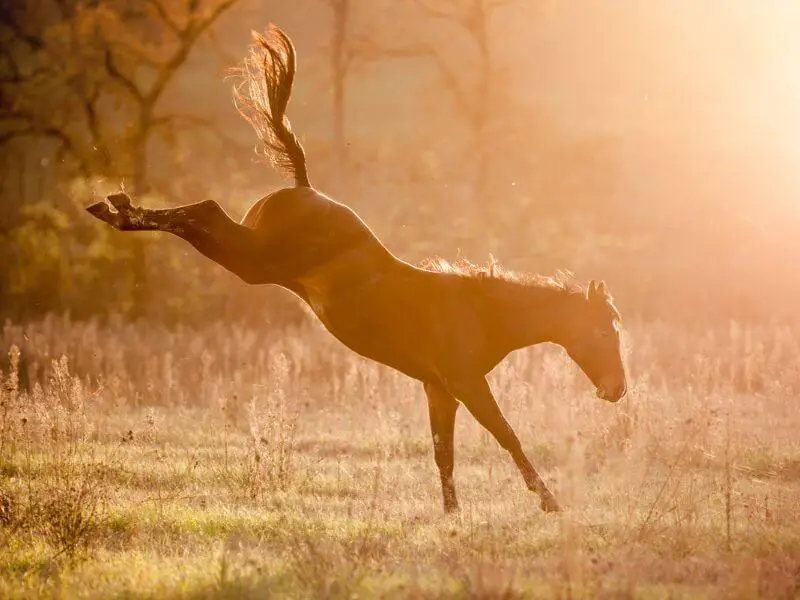
Sensory Perception & Behavior: Prey Responses
Now we’re going to chat about a fascinating part of horse behavior that has to do with their sensory perception. It’s like their own personal alarm system!
How Horses’ Eyesight And Visual Field Influence Their Behavior As Prey Animals
Have you ever wondered why a horse’s eyes are on the side of their head instead of the front like ours? Well, it’s all because horses are prey animals.
They have a super cool kind of vision called ‘monocular vision,’ which means each eye is used separately. This gives them an almost 360-degree field of vision, kind of like they have built-in binoculars!
This wide vision allows them to spot predators from almost any direction – up, down, left, right, you name it!
But, because their eyes work differently from ours, they might not be so good at telling how far away something is, which is why they might be a bit cautious around new or unfamiliar surfaces.
The Fight-Or-Flight Response In Horses And How Does It Relate To Their Prey Behavior
When a horse senses danger, it has two main options: stand its ground (fight) or run away (flight). This is called the ‘fight-or-flight’ response.
It’s like their brain flips a switch, sending a rush of adrenaline through their body, and prepping them to either sprint like a race car or stand tall and confront the threat.
However, as prey animals, horses usually choose flight over fight. It’s safer for them to run away and live to see another day. But don’t get it wrong – if they have to, they will defend themselves.
How Horses’ Eating Patterns Reflect Their Adaptation As Prey Animals
You know how we have breakfast, lunch, and dinner? Well, horses don’t really do that. Instead, they’re ‘trickle feeders’, which means they prefer to munch on small amounts of food throughout the day.
This eating style isn’t just because they like to snack (don’t we all?), but it also helps them stay alert for any lurking danger. Plus, their stomachs are designed to handle lots of small meals rather than a few big ones.
Some Common Sleep Patterns Observed In Horses As Prey Animals?
Horses have a pretty unique way of sleeping. They can sleep standing up and lying down, and they don’t sleep for long hours like we do. Instead, they take short naps throughout the day and night.
Why? Because in the wild, this sleep pattern means some members of the herd can rest while others keep watch for predators.
Psychological Disorders Horses Can Develop As A Result Of Their Innate Prey Instincts
When horses can’t live as their instincts tell them to – you know, like being able to graze freely or having companions around – it can really stress them out. This stress can sometimes lead to psychological disorders.
They might start behaving in weird ways, like biting on fences or stalls (called ‘cribbing’), swaying from side to side (known as ‘weaving’), or walking in circles in their stall (known as ‘stall-walking’).
These behaviors can be a sign that they’re bored, frustrated, or anxious, just like how you might feel if you were cooped up and couldn’t do the things you enjoy.
Effective Strategies For Approaching And Moving Around Horses Without Triggering Their Prey Response
Here’s a pro-tip for you when you’re around horses: always approach them calmly, confidently, and from the side. This is so you don’t surprise them and trigger their ‘danger’ alarm.
Also, try to avoid sudden movements and loud noises – you don’t want them to think you’re a predator!
Speak to them in a soft voice and use slow, gentle movements. That way, they’ll understand that you mean no harm. Remember, even though horses are big, their prey instincts make them extra cautious, so it’s up to us to show them we’re friends, not foes!
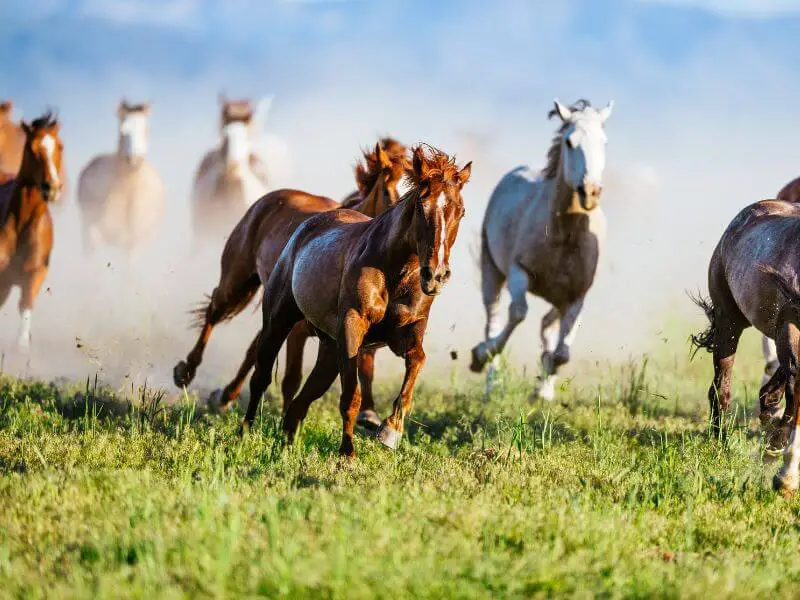
Conclusion
And there we have it, everything you needed to know about horses as prey animals!
We’ve dived into their complex lives and discovered how they’ve adapted to life in the wild, protecting themselves from predators.
From their ‘trickle feeding’ eating habits to their special ‘monocular’ vision and unique sleep patterns, these adaptations are not just fascinating—they’re also a testament to their resilience and survival skills.
We’ve also looked at how their natural prey instincts influence their behavior around humans. And remember, while these large, strong creatures can sometimes seem intimidating, they’re just trying to make sure they stay safe.
So, the next time you’re around horses, remember to approach them calmly and confidently, and always from the side to avoid startling them.
Understanding these magnificent creatures as prey animals can help us create a more comfortable and enriching environment for them, whether in the wild or in our care.
And most importantly, never forget that behind every horse behavior, there’s a reason rooted in their survival instincts.
So keep learning, keep observing, and keep appreciating these incredible creatures for the smart, adapted survivors they truly are.
Cheers, Kacey
P.S. Did you like this article? Gallop over to:

